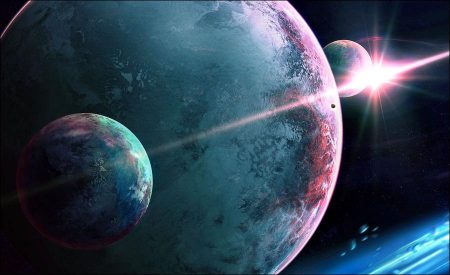The second multiverse theory arises from our best ideas about how our own Universe began.
According to the predominant view of the Big Bang, the Universe began as an infinitesimally tiny point and then expanded incredibly fast in a super-heated fireball. A fraction of a second after this expansion began, it may have fleetingly accelerated at a truly enormous rate, far faster than the speed of light. This burst is called “inflation”.
Inflationary theory explains why the Universe is relatively uniform everywhere we look. Inflation blew up the fireball to a cosmic scale before it had a chance to get too clumpy.
However, that primordial state would have been ruffled by tiny chance variations, which also got blown up by inflation. These fluctuations are now preserved in the cosmic microwave background radiation, the faint afterglow of the Big Bang. This radiation pervades the Universe, but it is not perfectly uniform.
Several satellite-based telescopes have mapped out these variations in fine detail, and compared them to those predicted by inflationary theory. The match is almost unbelievably good, suggesting that inflation really did happen.
This suggests that we can understand how the Big Bang happened – in which case we can reasonably ask if it happened more than once.
The current view is that the Big Bang happened when a patch of ordinary space, containing no matter but filled with energy, appeared within a different kind of space called the “false vacuum”. It then grew like an expanding bubble.
But according to this theory, the false vacuum should also experience a kind of inflation, causing it to expand at fantastic speed. Meanwhile, other bubble universes of “true vacuum” can appear within it – and not just, like our Universe, 13.8 billion years ago, but constantly.
This scenario is called “eternal inflation”. It suggests there are many, perhaps infinitely many, universes appearing and growing all the time. But we can never reach them, even if we travel at the speed of light forever, because they are receding too fast for us ever to catch up.
The UK Astronomer Royal Martin Rees suggests that the inflationary multiverse theory represents a “fourth Copernican revolution”: the fourth time that we have been forced to downgrade our status in the heavens. After Copernicus suggested Earth was just one planet among others, we realized that our Sun is just one star in our galaxy, and that other stars might have planets. Then we discovered that our galaxy is just one among countless more in an expanding Universe. And now perhaps our Universe is simply one of a crowd.
We do not yet know for sure if inflationary theory is true. However, if eternal inflation does create a multiverse from an endless series of Big Bangs, it could help to resolve one of the biggest problems in modern physics.
Next Page: The Theory of Everything
Views: 337



